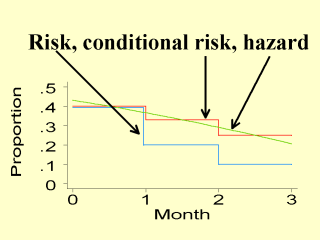 |
Suppose you followed 100 patients
for a fixed period of 3 months. The numbers of deaths in the first, second and third month
are 40, 20 and 10, respectively. The blue line indicates the risk of death during the three periods, i.e.
40/100=0.4, 20/100=0.2 and 10/100=0.1, respectively. The red
line indicates the risk of death in a time interval
conditional upon a subject has survived to the beginning of that interval (conditional
risk), i.e. 40/100=0.4, 20/60=0.33 and 10/40=0.25. For a large sample size, as the
measurement unit for time becomes small, e.g. one quarter of a month instead of one month,
the conditional risk divided by the width of time interval, e.g. 0.25 month in the present
case, will approach a smooth curve (green line). This is known as the hazard function. A hazard is the
conditional risk of failure in an extremely small time interval divided by the width of
the time interval. The concepts of hazard, hazard function and proportional hazard are
very important in survival analysis. |
